Person-Centred Care for Elderly Confusion
VerifiedAdded on 2020/06/06
|6
|2327
|58
AI Summary
This assignment focuses on the application of person-centred care in managing confusion and delirium among elderly patients. It emphasizes the importance of this approach in effectively treating these conditions and enabling older adults to return to their normal lives. The document cites relevant research and guidelines on urinary tract infections, a common cause of confusion in the elderly.
Contribute Materials
Your contribution can guide someone’s learning journey. Share your
documents today.
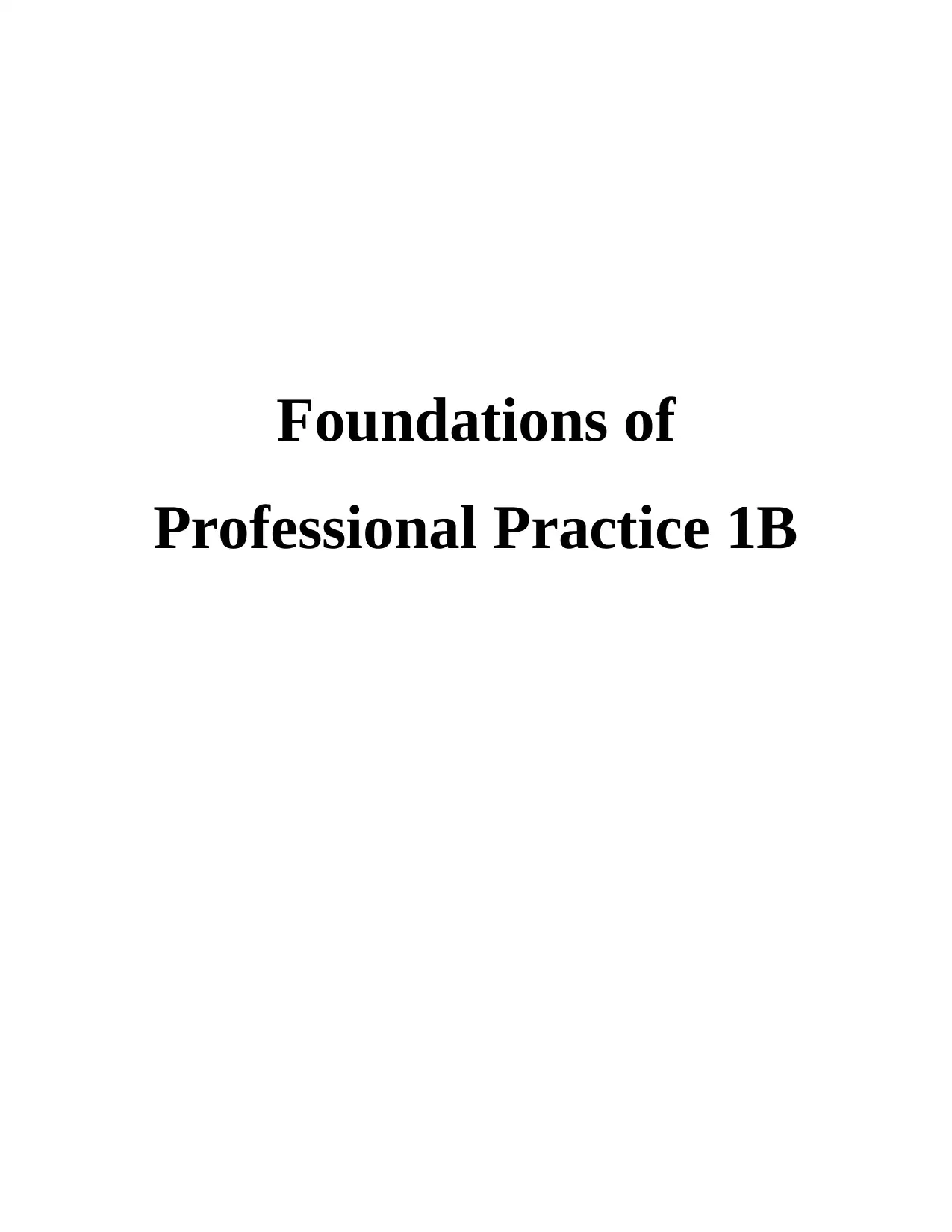
Foundations of
Professional Practice 1B
Professional Practice 1B
Secure Best Marks with AI Grader
Need help grading? Try our AI Grader for instant feedback on your assignments.
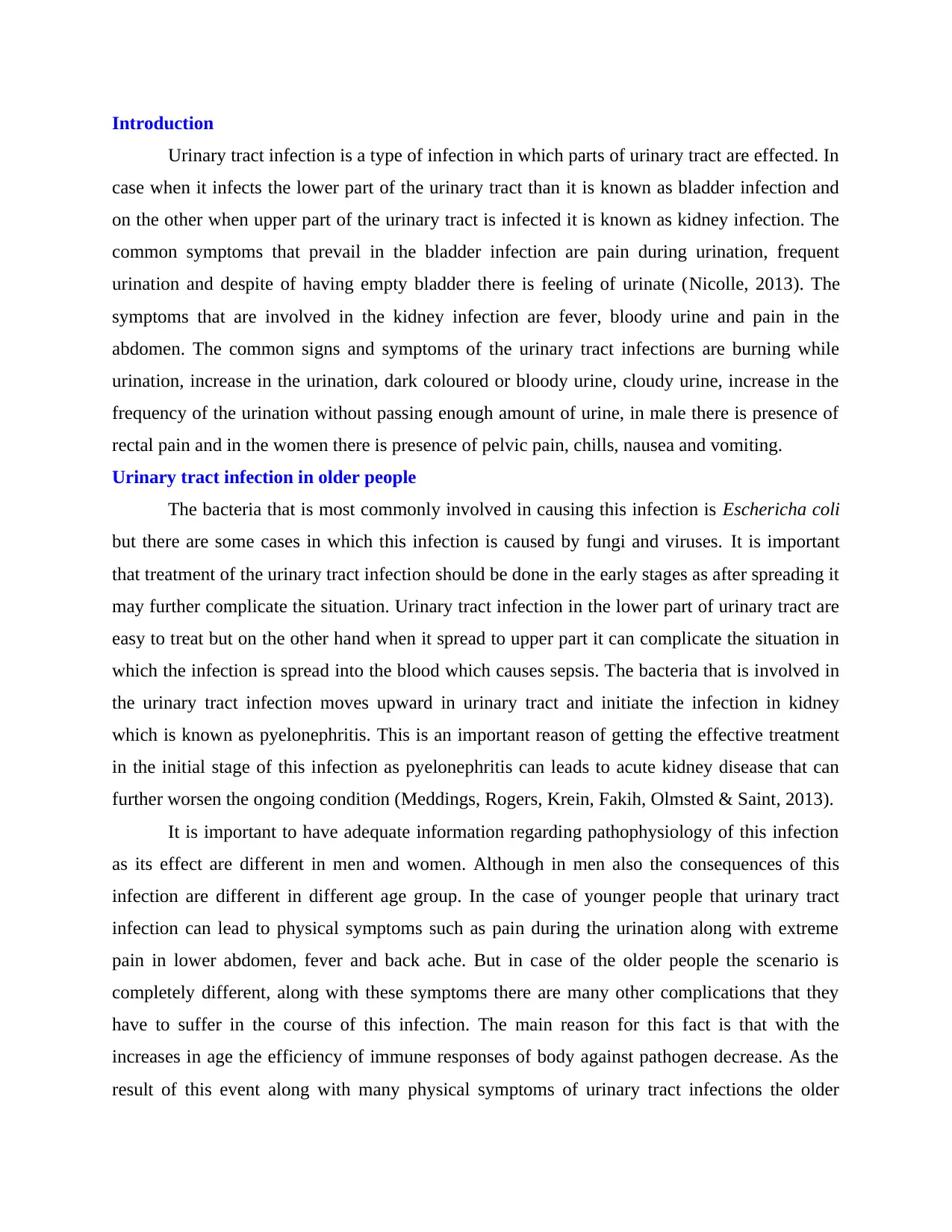
Introduction
Urinary tract infection is a type of infection in which parts of urinary tract are effected. In
case when it infects the lower part of the urinary tract than it is known as bladder infection and
on the other when upper part of the urinary tract is infected it is known as kidney infection. The
common symptoms that prevail in the bladder infection are pain during urination, frequent
urination and despite of having empty bladder there is feeling of urinate (Nicolle, 2013). The
symptoms that are involved in the kidney infection are fever, bloody urine and pain in the
abdomen. The common signs and symptoms of the urinary tract infections are burning while
urination, increase in the urination, dark coloured or bloody urine, cloudy urine, increase in the
frequency of the urination without passing enough amount of urine, in male there is presence of
rectal pain and in the women there is presence of pelvic pain, chills, nausea and vomiting.
Urinary tract infection in older people
The bacteria that is most commonly involved in causing this infection is Eschericha coli
but there are some cases in which this infection is caused by fungi and viruses. It is important
that treatment of the urinary tract infection should be done in the early stages as after spreading it
may further complicate the situation. Urinary tract infection in the lower part of urinary tract are
easy to treat but on the other hand when it spread to upper part it can complicate the situation in
which the infection is spread into the blood which causes sepsis. The bacteria that is involved in
the urinary tract infection moves upward in urinary tract and initiate the infection in kidney
which is known as pyelonephritis. This is an important reason of getting the effective treatment
in the initial stage of this infection as pyelonephritis can leads to acute kidney disease that can
further worsen the ongoing condition (Meddings, Rogers, Krein, Fakih, Olmsted & Saint, 2013).
It is important to have adequate information regarding pathophysiology of this infection
as its effect are different in men and women. Although in men also the consequences of this
infection are different in different age group. In the case of younger people that urinary tract
infection can lead to physical symptoms such as pain during the urination along with extreme
pain in lower abdomen, fever and back ache. But in case of the older people the scenario is
completely different, along with these symptoms there are many other complications that they
have to suffer in the course of this infection. The main reason for this fact is that with the
increases in age the efficiency of immune responses of body against pathogen decrease. As the
result of this event along with many physical symptoms of urinary tract infections the older
Urinary tract infection is a type of infection in which parts of urinary tract are effected. In
case when it infects the lower part of the urinary tract than it is known as bladder infection and
on the other when upper part of the urinary tract is infected it is known as kidney infection. The
common symptoms that prevail in the bladder infection are pain during urination, frequent
urination and despite of having empty bladder there is feeling of urinate (Nicolle, 2013). The
symptoms that are involved in the kidney infection are fever, bloody urine and pain in the
abdomen. The common signs and symptoms of the urinary tract infections are burning while
urination, increase in the urination, dark coloured or bloody urine, cloudy urine, increase in the
frequency of the urination without passing enough amount of urine, in male there is presence of
rectal pain and in the women there is presence of pelvic pain, chills, nausea and vomiting.
Urinary tract infection in older people
The bacteria that is most commonly involved in causing this infection is Eschericha coli
but there are some cases in which this infection is caused by fungi and viruses. It is important
that treatment of the urinary tract infection should be done in the early stages as after spreading it
may further complicate the situation. Urinary tract infection in the lower part of urinary tract are
easy to treat but on the other hand when it spread to upper part it can complicate the situation in
which the infection is spread into the blood which causes sepsis. The bacteria that is involved in
the urinary tract infection moves upward in urinary tract and initiate the infection in kidney
which is known as pyelonephritis. This is an important reason of getting the effective treatment
in the initial stage of this infection as pyelonephritis can leads to acute kidney disease that can
further worsen the ongoing condition (Meddings, Rogers, Krein, Fakih, Olmsted & Saint, 2013).
It is important to have adequate information regarding pathophysiology of this infection
as its effect are different in men and women. Although in men also the consequences of this
infection are different in different age group. In the case of younger people that urinary tract
infection can lead to physical symptoms such as pain during the urination along with extreme
pain in lower abdomen, fever and back ache. But in case of the older people the scenario is
completely different, along with these symptoms there are many other complications that they
have to suffer in the course of this infection. The main reason for this fact is that with the
increases in age the efficiency of immune responses of body against pathogen decrease. As the
result of this event along with many physical symptoms of urinary tract infections the older
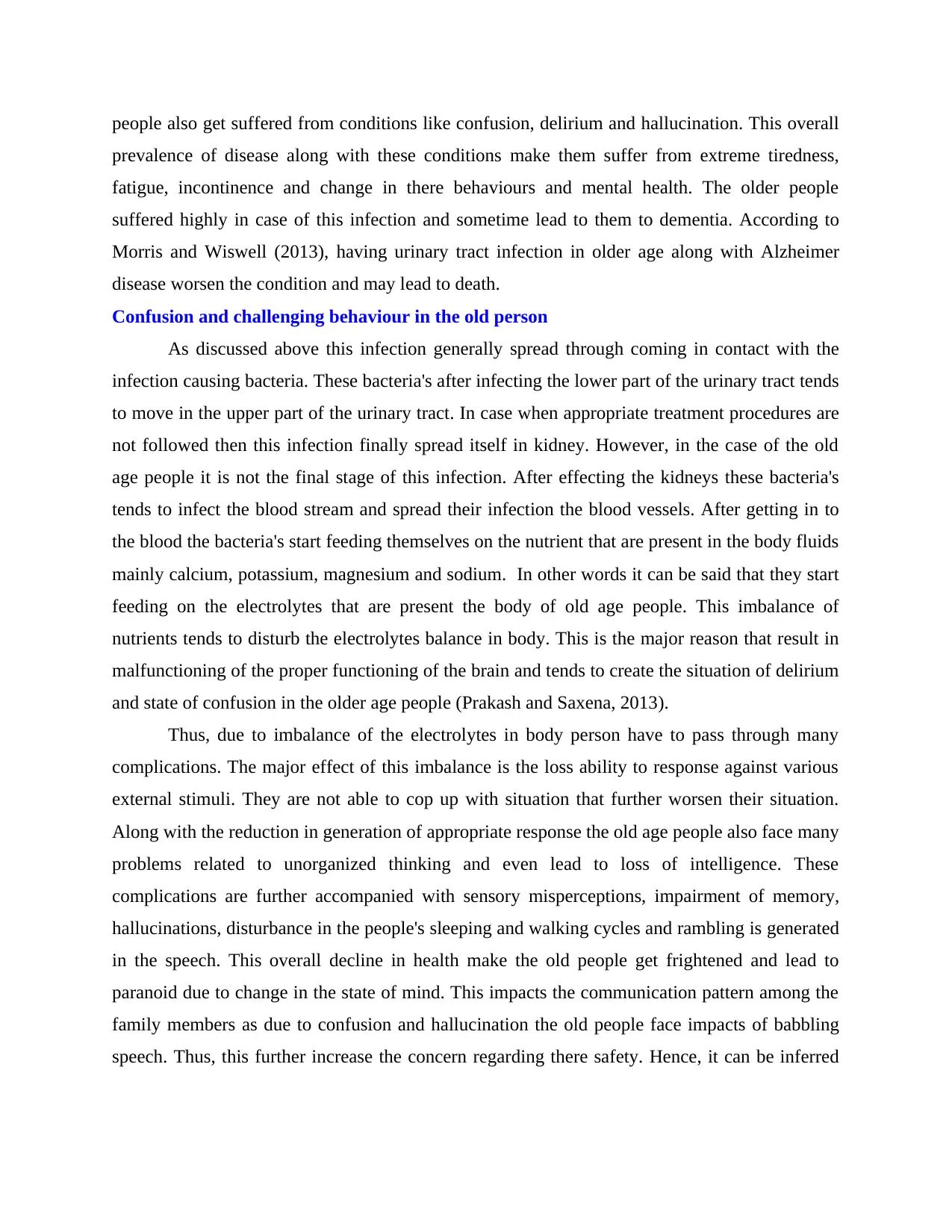
people also get suffered from conditions like confusion, delirium and hallucination. This overall
prevalence of disease along with these conditions make them suffer from extreme tiredness,
fatigue, incontinence and change in there behaviours and mental health. The older people
suffered highly in case of this infection and sometime lead to them to dementia. According to
Morris and Wiswell (2013), having urinary tract infection in older age along with Alzheimer
disease worsen the condition and may lead to death.
Confusion and challenging behaviour in the old person
As discussed above this infection generally spread through coming in contact with the
infection causing bacteria. These bacteria's after infecting the lower part of the urinary tract tends
to move in the upper part of the urinary tract. In case when appropriate treatment procedures are
not followed then this infection finally spread itself in kidney. However, in the case of the old
age people it is not the final stage of this infection. After effecting the kidneys these bacteria's
tends to infect the blood stream and spread their infection the blood vessels. After getting in to
the blood the bacteria's start feeding themselves on the nutrient that are present in the body fluids
mainly calcium, potassium, magnesium and sodium. In other words it can be said that they start
feeding on the electrolytes that are present the body of old age people. This imbalance of
nutrients tends to disturb the electrolytes balance in body. This is the major reason that result in
malfunctioning of the proper functioning of the brain and tends to create the situation of delirium
and state of confusion in the older age people (Prakash and Saxena, 2013).
Thus, due to imbalance of the electrolytes in body person have to pass through many
complications. The major effect of this imbalance is the loss ability to response against various
external stimuli. They are not able to cop up with situation that further worsen their situation.
Along with the reduction in generation of appropriate response the old age people also face many
problems related to unorganized thinking and even lead to loss of intelligence. These
complications are further accompanied with sensory misperceptions, impairment of memory,
hallucinations, disturbance in the people's sleeping and walking cycles and rambling is generated
in the speech. This overall decline in health make the old people get frightened and lead to
paranoid due to change in the state of mind. This impacts the communication pattern among the
family members as due to confusion and hallucination the old people face impacts of babbling
speech. Thus, this further increase the concern regarding there safety. Hence, it can be inferred
prevalence of disease along with these conditions make them suffer from extreme tiredness,
fatigue, incontinence and change in there behaviours and mental health. The older people
suffered highly in case of this infection and sometime lead to them to dementia. According to
Morris and Wiswell (2013), having urinary tract infection in older age along with Alzheimer
disease worsen the condition and may lead to death.
Confusion and challenging behaviour in the old person
As discussed above this infection generally spread through coming in contact with the
infection causing bacteria. These bacteria's after infecting the lower part of the urinary tract tends
to move in the upper part of the urinary tract. In case when appropriate treatment procedures are
not followed then this infection finally spread itself in kidney. However, in the case of the old
age people it is not the final stage of this infection. After effecting the kidneys these bacteria's
tends to infect the blood stream and spread their infection the blood vessels. After getting in to
the blood the bacteria's start feeding themselves on the nutrient that are present in the body fluids
mainly calcium, potassium, magnesium and sodium. In other words it can be said that they start
feeding on the electrolytes that are present the body of old age people. This imbalance of
nutrients tends to disturb the electrolytes balance in body. This is the major reason that result in
malfunctioning of the proper functioning of the brain and tends to create the situation of delirium
and state of confusion in the older age people (Prakash and Saxena, 2013).
Thus, due to imbalance of the electrolytes in body person have to pass through many
complications. The major effect of this imbalance is the loss ability to response against various
external stimuli. They are not able to cop up with situation that further worsen their situation.
Along with the reduction in generation of appropriate response the old age people also face many
problems related to unorganized thinking and even lead to loss of intelligence. These
complications are further accompanied with sensory misperceptions, impairment of memory,
hallucinations, disturbance in the people's sleeping and walking cycles and rambling is generated
in the speech. This overall decline in health make the old people get frightened and lead to
paranoid due to change in the state of mind. This impacts the communication pattern among the
family members as due to confusion and hallucination the old people face impacts of babbling
speech. Thus, this further increase the concern regarding there safety. Hence, it can be inferred
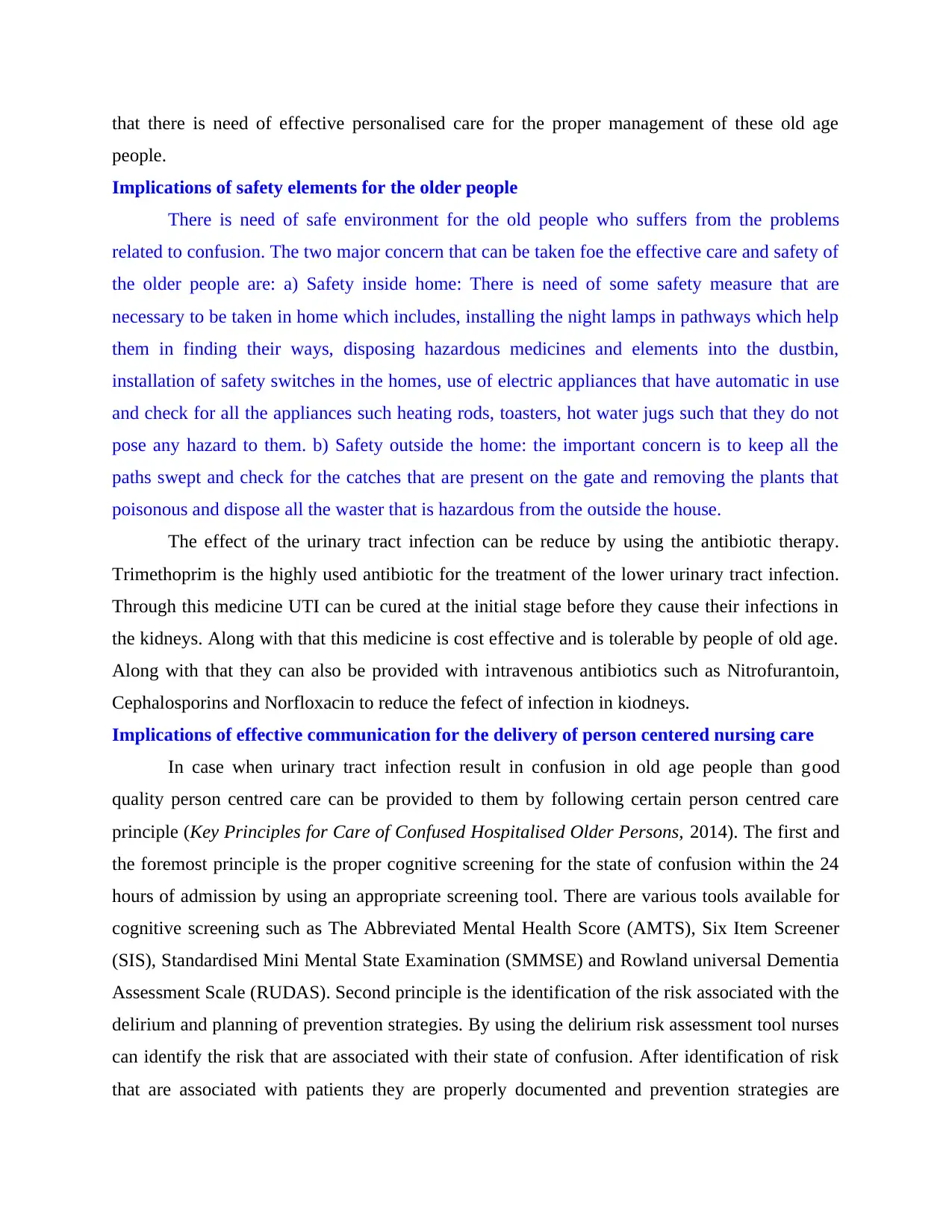
that there is need of effective personalised care for the proper management of these old age
people.
Implications of safety elements for the older people
There is need of safe environment for the old people who suffers from the problems
related to confusion. The two major concern that can be taken foe the effective care and safety of
the older people are: a) Safety inside home: There is need of some safety measure that are
necessary to be taken in home which includes, installing the night lamps in pathways which help
them in finding their ways, disposing hazardous medicines and elements into the dustbin,
installation of safety switches in the homes, use of electric appliances that have automatic in use
and check for all the appliances such heating rods, toasters, hot water jugs such that they do not
pose any hazard to them. b) Safety outside the home: the important concern is to keep all the
paths swept and check for the catches that are present on the gate and removing the plants that
poisonous and dispose all the waster that is hazardous from the outside the house.
The effect of the urinary tract infection can be reduce by using the antibiotic therapy.
Trimethoprim is the highly used antibiotic for the treatment of the lower urinary tract infection.
Through this medicine UTI can be cured at the initial stage before they cause their infections in
the kidneys. Along with that this medicine is cost effective and is tolerable by people of old age.
Along with that they can also be provided with intravenous antibiotics such as Nitrofurantoin,
Cephalosporins and Norfloxacin to reduce the fefect of infection in kiodneys.
Implications of effective communication for the delivery of person centered nursing care
In case when urinary tract infection result in confusion in old age people than good
quality person centred care can be provided to them by following certain person centred care
principle (Key Principles for Care of Confused Hospitalised Older Persons, 2014). The first and
the foremost principle is the proper cognitive screening for the state of confusion within the 24
hours of admission by using an appropriate screening tool. There are various tools available for
cognitive screening such as The Abbreviated Mental Health Score (AMTS), Six Item Screener
(SIS), Standardised Mini Mental State Examination (SMMSE) and Rowland universal Dementia
Assessment Scale (RUDAS). Second principle is the identification of the risk associated with the
delirium and planning of prevention strategies. By using the delirium risk assessment tool nurses
can identify the risk that are associated with their state of confusion. After identification of risk
that are associated with patients they are properly documented and prevention strategies are
people.
Implications of safety elements for the older people
There is need of safe environment for the old people who suffers from the problems
related to confusion. The two major concern that can be taken foe the effective care and safety of
the older people are: a) Safety inside home: There is need of some safety measure that are
necessary to be taken in home which includes, installing the night lamps in pathways which help
them in finding their ways, disposing hazardous medicines and elements into the dustbin,
installation of safety switches in the homes, use of electric appliances that have automatic in use
and check for all the appliances such heating rods, toasters, hot water jugs such that they do not
pose any hazard to them. b) Safety outside the home: the important concern is to keep all the
paths swept and check for the catches that are present on the gate and removing the plants that
poisonous and dispose all the waster that is hazardous from the outside the house.
The effect of the urinary tract infection can be reduce by using the antibiotic therapy.
Trimethoprim is the highly used antibiotic for the treatment of the lower urinary tract infection.
Through this medicine UTI can be cured at the initial stage before they cause their infections in
the kidneys. Along with that this medicine is cost effective and is tolerable by people of old age.
Along with that they can also be provided with intravenous antibiotics such as Nitrofurantoin,
Cephalosporins and Norfloxacin to reduce the fefect of infection in kiodneys.
Implications of effective communication for the delivery of person centered nursing care
In case when urinary tract infection result in confusion in old age people than good
quality person centred care can be provided to them by following certain person centred care
principle (Key Principles for Care of Confused Hospitalised Older Persons, 2014). The first and
the foremost principle is the proper cognitive screening for the state of confusion within the 24
hours of admission by using an appropriate screening tool. There are various tools available for
cognitive screening such as The Abbreviated Mental Health Score (AMTS), Six Item Screener
(SIS), Standardised Mini Mental State Examination (SMMSE) and Rowland universal Dementia
Assessment Scale (RUDAS). Second principle is the identification of the risk associated with the
delirium and planning of prevention strategies. By using the delirium risk assessment tool nurses
can identify the risk that are associated with their state of confusion. After identification of risk
that are associated with patients they are properly documented and prevention strategies are
Secure Best Marks with AI Grader
Need help grading? Try our AI Grader for instant feedback on your assignments.
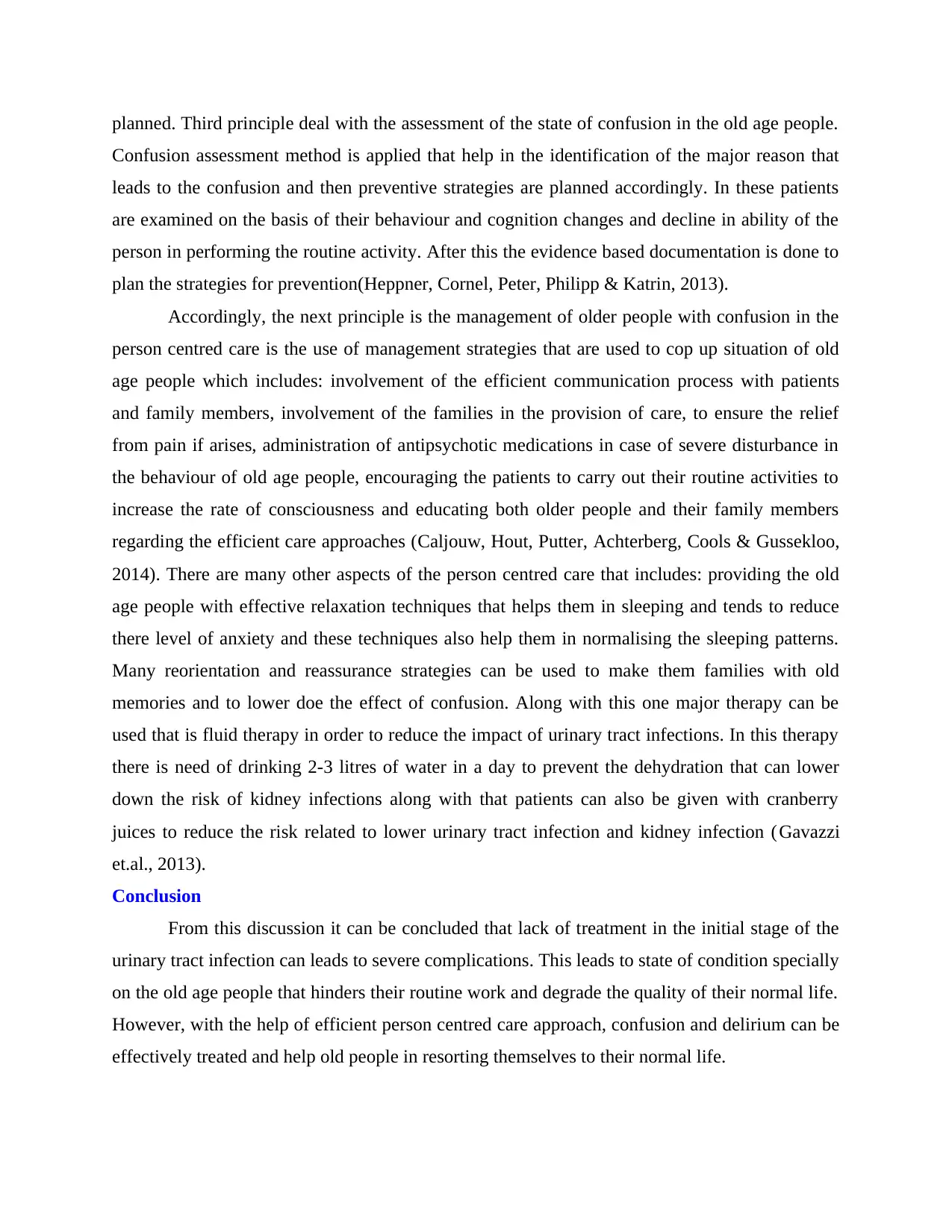
planned. Third principle deal with the assessment of the state of confusion in the old age people.
Confusion assessment method is applied that help in the identification of the major reason that
leads to the confusion and then preventive strategies are planned accordingly. In these patients
are examined on the basis of their behaviour and cognition changes and decline in ability of the
person in performing the routine activity. After this the evidence based documentation is done to
plan the strategies for prevention(Heppner, Cornel, Peter, Philipp & Katrin, 2013).
Accordingly, the next principle is the management of older people with confusion in the
person centred care is the use of management strategies that are used to cop up situation of old
age people which includes: involvement of the efficient communication process with patients
and family members, involvement of the families in the provision of care, to ensure the relief
from pain if arises, administration of antipsychotic medications in case of severe disturbance in
the behaviour of old age people, encouraging the patients to carry out their routine activities to
increase the rate of consciousness and educating both older people and their family members
regarding the efficient care approaches (Caljouw, Hout, Putter, Achterberg, Cools & Gussekloo,
2014). There are many other aspects of the person centred care that includes: providing the old
age people with effective relaxation techniques that helps them in sleeping and tends to reduce
there level of anxiety and these techniques also help them in normalising the sleeping patterns.
Many reorientation and reassurance strategies can be used to make them families with old
memories and to lower doe the effect of confusion. Along with this one major therapy can be
used that is fluid therapy in order to reduce the impact of urinary tract infections. In this therapy
there is need of drinking 2-3 litres of water in a day to prevent the dehydration that can lower
down the risk of kidney infections along with that patients can also be given with cranberry
juices to reduce the risk related to lower urinary tract infection and kidney infection (Gavazzi
et.al., 2013).
Conclusion
From this discussion it can be concluded that lack of treatment in the initial stage of the
urinary tract infection can leads to severe complications. This leads to state of condition specially
on the old age people that hinders their routine work and degrade the quality of their normal life.
However, with the help of efficient person centred care approach, confusion and delirium can be
effectively treated and help old people in resorting themselves to their normal life.
Confusion assessment method is applied that help in the identification of the major reason that
leads to the confusion and then preventive strategies are planned accordingly. In these patients
are examined on the basis of their behaviour and cognition changes and decline in ability of the
person in performing the routine activity. After this the evidence based documentation is done to
plan the strategies for prevention(Heppner, Cornel, Peter, Philipp & Katrin, 2013).
Accordingly, the next principle is the management of older people with confusion in the
person centred care is the use of management strategies that are used to cop up situation of old
age people which includes: involvement of the efficient communication process with patients
and family members, involvement of the families in the provision of care, to ensure the relief
from pain if arises, administration of antipsychotic medications in case of severe disturbance in
the behaviour of old age people, encouraging the patients to carry out their routine activities to
increase the rate of consciousness and educating both older people and their family members
regarding the efficient care approaches (Caljouw, Hout, Putter, Achterberg, Cools & Gussekloo,
2014). There are many other aspects of the person centred care that includes: providing the old
age people with effective relaxation techniques that helps them in sleeping and tends to reduce
there level of anxiety and these techniques also help them in normalising the sleeping patterns.
Many reorientation and reassurance strategies can be used to make them families with old
memories and to lower doe the effect of confusion. Along with this one major therapy can be
used that is fluid therapy in order to reduce the impact of urinary tract infections. In this therapy
there is need of drinking 2-3 litres of water in a day to prevent the dehydration that can lower
down the risk of kidney infections along with that patients can also be given with cranberry
juices to reduce the risk related to lower urinary tract infection and kidney infection (Gavazzi
et.al., 2013).
Conclusion
From this discussion it can be concluded that lack of treatment in the initial stage of the
urinary tract infection can leads to severe complications. This leads to state of condition specially
on the old age people that hinders their routine work and degrade the quality of their normal life.
However, with the help of efficient person centred care approach, confusion and delirium can be
effectively treated and help old people in resorting themselves to their normal life.
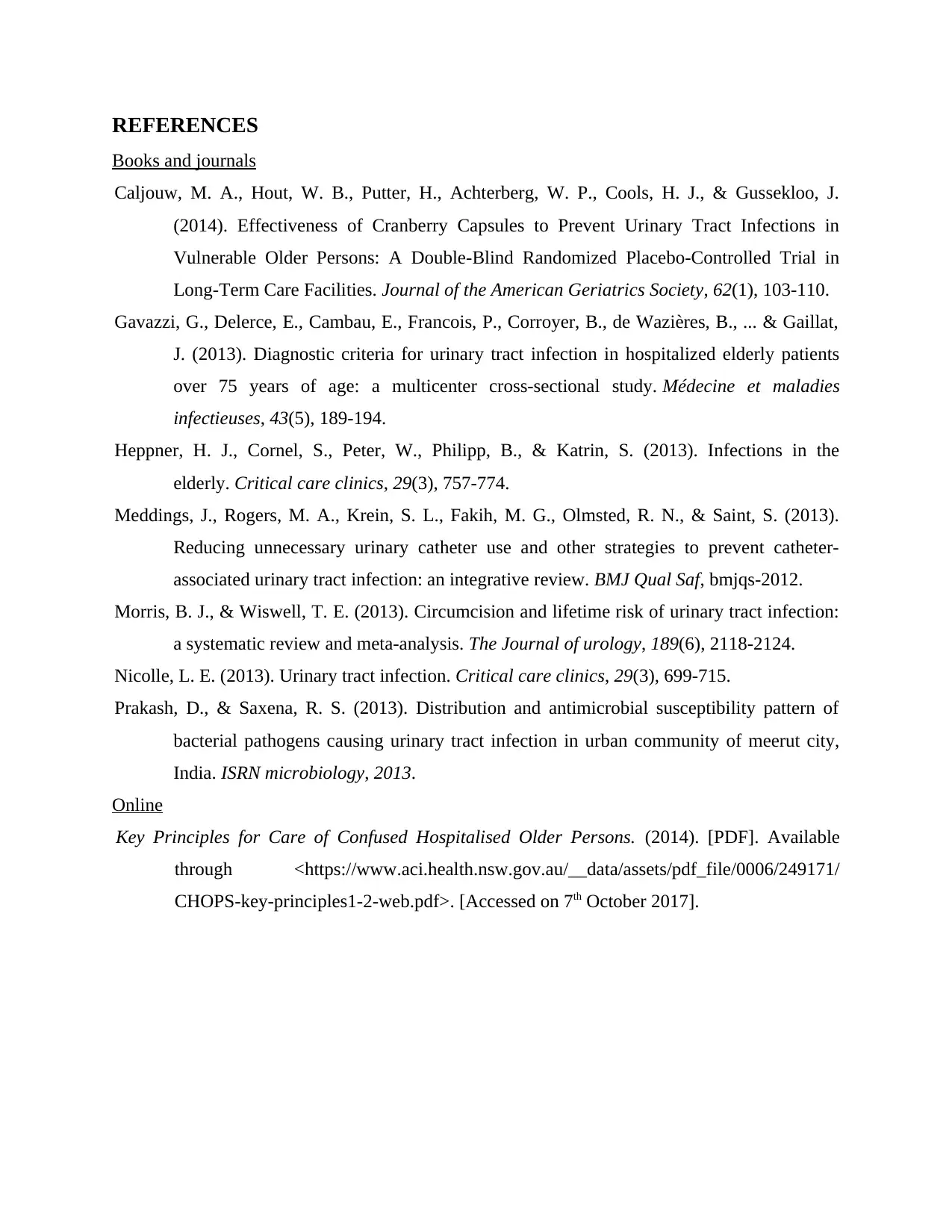
REFERENCES
Books and journals
Caljouw, M. A., Hout, W. B., Putter, H., Achterberg, W. P., Cools, H. J., & Gussekloo, J.
(2014). Effectiveness of Cranberry Capsules to Prevent Urinary Tract Infections in
Vulnerable Older Persons: A Double‐Blind Randomized Placebo‐Controlled Trial in
Long‐Term Care Facilities. Journal of the American Geriatrics Society, 62(1), 103-110.
Gavazzi, G., Delerce, E., Cambau, E., Francois, P., Corroyer, B., de Wazières, B., ... & Gaillat,
J. (2013). Diagnostic criteria for urinary tract infection in hospitalized elderly patients
over 75 years of age: a multicenter cross-sectional study. Médecine et maladies
infectieuses, 43(5), 189-194.
Heppner, H. J., Cornel, S., Peter, W., Philipp, B., & Katrin, S. (2013). Infections in the
elderly. Critical care clinics, 29(3), 757-774.
Meddings, J., Rogers, M. A., Krein, S. L., Fakih, M. G., Olmsted, R. N., & Saint, S. (2013).
Reducing unnecessary urinary catheter use and other strategies to prevent catheter-
associated urinary tract infection: an integrative review. BMJ Qual Saf, bmjqs-2012.
Morris, B. J., & Wiswell, T. E. (2013). Circumcision and lifetime risk of urinary tract infection:
a systematic review and meta-analysis. The Journal of urology, 189(6), 2118-2124.
Nicolle, L. E. (2013). Urinary tract infection. Critical care clinics, 29(3), 699-715.
Prakash, D., & Saxena, R. S. (2013). Distribution and antimicrobial susceptibility pattern of
bacterial pathogens causing urinary tract infection in urban community of meerut city,
India. ISRN microbiology, 2013.
Online
Key Principles for Care of Confused Hospitalised Older Persons. (2014). [PDF]. Available
through <https://www.aci.health.nsw.gov.au/__data/assets/pdf_file/0006/249171/
CHOPS-key-principles1-2-web.pdf>. [Accessed on 7th October 2017].
Books and journals
Caljouw, M. A., Hout, W. B., Putter, H., Achterberg, W. P., Cools, H. J., & Gussekloo, J.
(2014). Effectiveness of Cranberry Capsules to Prevent Urinary Tract Infections in
Vulnerable Older Persons: A Double‐Blind Randomized Placebo‐Controlled Trial in
Long‐Term Care Facilities. Journal of the American Geriatrics Society, 62(1), 103-110.
Gavazzi, G., Delerce, E., Cambau, E., Francois, P., Corroyer, B., de Wazières, B., ... & Gaillat,
J. (2013). Diagnostic criteria for urinary tract infection in hospitalized elderly patients
over 75 years of age: a multicenter cross-sectional study. Médecine et maladies
infectieuses, 43(5), 189-194.
Heppner, H. J., Cornel, S., Peter, W., Philipp, B., & Katrin, S. (2013). Infections in the
elderly. Critical care clinics, 29(3), 757-774.
Meddings, J., Rogers, M. A., Krein, S. L., Fakih, M. G., Olmsted, R. N., & Saint, S. (2013).
Reducing unnecessary urinary catheter use and other strategies to prevent catheter-
associated urinary tract infection: an integrative review. BMJ Qual Saf, bmjqs-2012.
Morris, B. J., & Wiswell, T. E. (2013). Circumcision and lifetime risk of urinary tract infection:
a systematic review and meta-analysis. The Journal of urology, 189(6), 2118-2124.
Nicolle, L. E. (2013). Urinary tract infection. Critical care clinics, 29(3), 699-715.
Prakash, D., & Saxena, R. S. (2013). Distribution and antimicrobial susceptibility pattern of
bacterial pathogens causing urinary tract infection in urban community of meerut city,
India. ISRN microbiology, 2013.
Online
Key Principles for Care of Confused Hospitalised Older Persons. (2014). [PDF]. Available
through <https://www.aci.health.nsw.gov.au/__data/assets/pdf_file/0006/249171/
CHOPS-key-principles1-2-web.pdf>. [Accessed on 7th October 2017].
1 out of 6
Related Documents
Your All-in-One AI-Powered Toolkit for Academic Success.
+13062052269
info@desklib.com
Available 24*7 on WhatsApp / Email
![[object Object]](/_next/static/media/star-bottom.7253800d.svg)
Unlock your academic potential
© 2024 | Zucol Services PVT LTD | All rights reserved.





